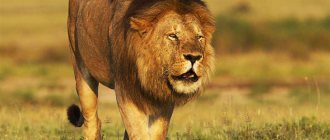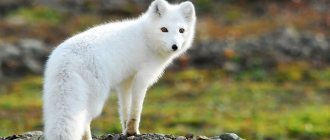North and its nature
The concept of “North” is rather vague and has no specific definition either in geography, ecology, or other scientific fields. Traditionally, it denotes areas close to the pole, which are characterized by extreme weather conditions.
Typically, the North includes the zone of the Arctic desert, tundra, and islands in the Arctic Ocean. The taiga zone is often included in this category. The region does not have clear boundaries, but it is believed that it partially covers the territory of Russia, Canada, the USA (Alaska), Norway, Sweden, Finland, and completely includes Iceland and the island of Greenland.
Plants and animals of the North are in very difficult conditions for life and exist rather in spite of than because of them. The region's climate tends to sub-zero temperatures. The closer to the pole, the more severe and tough it is. In the taiga the conditions are mildest and most pleasant. It is covered with forests and has sufficient food supply for animals.
The classic North begins with the tundra, and we will devote this article to it. There are no trees and very few shrubs in its expanses. The main representatives of the plant world are lichens, mosses, and ephemeral plants that appear only in short spring or summer periods. Winter here lasts from 6 to 9 months a year, and summer may not exist at all.
Arctic wolf
The Arctic tundra belongs to polar wolves. They have acute night vision and the skills of excellent hunters.
The Arctic wolf's thick fur allows it to withstand the low temperatures of the snowy Arctic. This fact is noted by the World Wildlife Fund. During the winter season, the animal's second layer of fur is even thickened to provide additional warmth. Arctic wolves can survive in conditions of five months of complete darkness.
The color makes it possible to blend in with the snow cover, which is very convenient for camouflage while hunting large herbivores. Wolves can chase musk oxen, moose, and caribou. In one day they can cover a distance of 100 km.
Characteristics of animals of the North
The region's wildlife is unique and in some ways unusual. In order not to die from the extreme cold and the meager menu, its representatives had to try hard. Some have acquired long, thick hair, others have acquired a thick layer of fat. Due to weak vegetation cover, many inhabitants of the Arctic and Subarctic are predators and prefer to hunt other animals. Herbivorous species feed on algae, grasses, mosses and lichens.
Among the most famous names of animals of the North: polar bear, reindeer, arctic fox, lemming, musk ox, polar owl and brown hare. In addition to them, the harsh region is inhabited by numerous cetaceans, waterfowl and land birds, as well as various marine inhabitants.
Some species are now listed in the Red Book. Animals of the North that are considered endangered or vulnerable are Atlantic walruses, ivory gulls, narwhals, polar bears, bowhead whales, and puffin birds. Beluga whales and thick-billed guillemots are considered close to vulnerable.
Amazing birds
The cold region with a harsh climate called the Arctic surprises with its diversity of fauna. Birds also found their place on this piece of land.
White Owl
A very beautiful bird. This is a harsh predator that is constantly in flight for prey. The wingspan of an owl can reach up to 1.5 meters. Males are smaller in size than females and have a distinctive feature in the form of black specks. The eyes are yellow, the ears are so small that they are not visible. The beak is black, but completely hidden under the plumage.
Long claws help them hunt and perch comfortably on elevated places. The diet consists of small mammals.
Interesting fact! In times when there is not enough food, owls stop breeding for this time and fly closer to the southern regions.
Pink seagull
Despite the strong cold winds, this small bird has found its home in the Arctic. It builds nests on the shores of the ocean. The seagull is no more than 35 cm long and weighs only 250 grams. The head is pale pink, and the back and wings are gray. The paws are bright red, and on her neck there is a black collar, which disappears with the onset of severe cold. Swims well in water and can sometimes land on ice floes. It feeds mainly on small insects, fish, crustaceans and mollusks. These fragile birds are often targeted by predators. They are hunted by Arctic foxes and reindeer.
Lyurik
The little auk is the second name for these birds. They nest in high latitudes. Little auks are the most mobile and smallest inhabitants of the Arctic among birds.
They move on land very deftly and quickly. They also feel confident at sea. Great maneuverability and frequent flaps during flight resemble a large insect rather than a bird. The color of the plumage resembles a tailcoat.
Arctic animals are in a daily struggle for life. Natural selection is cruel. Despite this, the northern region shelters a variety of fauna on its land.
Polar bear
The polar bear is perhaps the most famous and largest land animal of the North. Along with the brown Kodiak, it is considered the largest land predator on Earth. It reaches about three meters in length and weighs 400-500 kilograms. The largest representatives of the species inhabit the coast of the Bering Sea.
The polar bear, or nanuk, lives in the polar regions of North America and Eurasia, as well as in Iceland, Spitsbergen and Greenland. It lives on fast ice and drifting ice floes, and in winter it can come to the mainland. To feed itself, it needs a lot of nutritious food, so the bear's main prey is sea hares, walruses and seals. In addition to them, the predator can eat algae, fish and carrion, as well as rob freight forwarders' warehouses and clear out garbage dumps in residential villages.
Elephant
A branch in the forest did not crunch, a leaf did not move - a huge wild elephant silently emerged from the dense thickets of the jungle.
The elephant stands like a towering gray mountain: legs like logs, ears like two sails, long tusks, crooked and strong. The elephant stretched out its trunk, tore a bush out of the ground, put it whole in its mouth and began to chew.
Such a strong man is not afraid of anyone, no one is afraid of him.
Lemming
Lemmings are small rodents that belong to the hamster family and live in Eurasia and North America. They grow to only 15 centimeters in length and weigh only 30-70 grams. But the animals eat excellently, absorbing twice as much food per day as they weigh themselves.
The largest among them is Vinogradov's lemming, endemic to the North of Russia. The animal inhabits exclusively Wrangel Island and has protected status. The body size of Vinogradov's lemming reaches 16-17 centimeters. The animal is ash-colored with spots of brown and beige. It settles in underground burrows on the slopes of hills, constructing many tunnels, storage rooms and exits in them. The area of one burrow can reach 30 m2.
Arctic tern
This bird is always on the move. According to the Cornell Lab of Ornithology, the migratory route of these birds is about 40 km each day. They leave their Arctic breeding grounds to find a winter home in Antarctica. These are the longest annual journeys of any bird.
According to the Audubon Guide to North American Birds, groups of these birds perform high aerial flights.
Found a violation? Report content
Thick-billed or short-billed guillemot
The guillemot seabird is a regular at bird markets on the coast of Eurasia. It is distributed from Murmansk to Chukotka and Kamchatka, and is found in the Aleutian Islands and Alaska. Externally, the short-billed guillemot resembles a mixture of a duck and a penguin. The bird's color is two-color: the back, sides and head are covered with black plumage, and the inside of the neck and belly are completely white.
Guillemots settle on coastal cliffs and are located only in large flocks, surrounded by other seabirds, such as gulls. They are not migratory and winter in the Arctic. However, with the arrival of winter they move a little further south.
Beluga
The original whale forehead is called a melon, and the beluga can change the shape of its melon by moving air around its sinuses. This fact is noted by the World Wildlife Fund. Also, the original structure of the forehead can help these whales with echolocation.
Due to their wide range of vocalizations, belugas are sometimes called sea canaries. They produce at least eleven different sounds, from chirping to whistles, and belugas in captivity can even imitate the sounds of human speech.
Narwhal
This animal of the North is the living embodiment of the unicorn. It only lives in water and is not at all like a horse. But from the animal’s mouth protrudes a long spiral-twisted tusk, reminiscent of a horn. A huge tooth weighing up to 10 kilograms and up to 3 meters in length was considered a valuable trophy and became the reason for the widespread extermination of narwhals. Today they are considered a rare species.
The narwhal is a cetacean and is similar in appearance to beluga whales. It lives in the waters of the Arctic Ocean, constantly migrating, depending on the movement of floating ice. In summer, animals stay in the depths, and in winter they move closer to the coast. They prey on medium and small fish, mollusks and crustaceans. They themselves become prey for polar sharks, polar bears and killer whales.
a lion
Watch out, zebras are striped horses! Beware, fast antelopes! Beware, steep-horned wild buffalos!
The lion is out hunting!
It was as if thunder thundered and rolled through the bushes and thickets. This is a lion's roar, a lion's roar. And all the animals hid.
The lion is the strongest, the most terrible of all. His mane is thick, his claws are sharp, and his teeth are strong.
Who will he catch this night?
Musk ox or musk ox
The massive and stocky musk ox has skillfully adapted to the harsh conditions of the North. The animal has thick, long hair and no protruding body parts, which helps it retain heat better and cope with strong winds and frosts. Its hair can reach almost 60 centimeters in length and hangs almost to the ground.
The musk ox reaches 120-150 centimeters at the withers and weighs 200-350 kilograms. Because of their fur, animals seem even larger than they really are. For example, their closest relative, the takin, looks much slimmer.
The ancestors of these animals came out of the Himalayan mountains and settled throughout Eurasia. Today they are found mainly on the islands of the Canadian archipelago, in the north of mainland Canada and Greenland. Some populations live on the Scandinavian Peninsula and Siberia.
bearded seals
Bearded seals hit their heads on the thin ice, creating breathing holes. This is evidenced by the National Oceanic and Atmospheric Administration.
Andrei Mironov cried when his mother forbade him to marry the beauty Fateeva
Flower vase made from scrap materials: you need a ball, paper, cement and paint
Prevention of ulcers and more: why do the Chinese constantly drink boiling water
Scientists say male animals can sing. They perform underwater vocalizations to attract females during mating season.
Atlantic dead end
The puffin seabird from the auk family looks a little exotic. Its back, upper head and neck are black, its chest, belly and large eye patch are white, and its legs and beak are bright orange. The bird got its name due to its large rounded beak, with which it not only captures prey, but also attracts a partner during the mating season.
The puffin settles in burrows on the coasts of the Atlantic and Arctic Oceans. The bird is found mainly in Northern Europe, the Kola Peninsula, on the Ainovsky and British Islands, on the shores of Spitsbergen, Newfoundland, Labrador and Greenland.
It feeds on fish, mollusks and crustaceans. The Atlantic puffin is an excellent diver, swims quickly and can hold its breath for a minute underwater. In winter, birds spend all their time in the water, staying afloat even in their sleep. They arrive on the coast only during the breeding season.
Canada lynx
As Big Cat Rescue notes, the Canadian lynx has large paws with splayed toes that allow it to move across snowy terrain. Like built-in snowshoes, these large paws help distribute the animal's weight more evenly.
Doctors have learned to screen for dementia in 5 minutes
SSC Tuatara's second attempt at record speed fails
Worms in the composition: why you shouldn’t fertilize plants with chicken droppings
Canada lynxes primarily feed on hares, which they capture in a surprise attack.
“Canada lynx can wait for prey in a shelter for several hours until the moment is right to capture it,” reports Canadian Geographic.
Rhinoceros
The branches in the forest crack, the trees sway and shake. This is a huge beast - a rhinoceros - bursting straight through the tropical thicket. He doesn’t care about thorns and thorns, hard branches and stumps. His skin is thick and strong, like armor: a spear will bounce off it, an arrow will break. Only a rifle bullet can pierce such skin.
The rhinoceros has a large horn on its nose, and its eyes are small and blind. He can't see well with them. He doesn’t really understand anything, but immediately rushes to butt heads.
A hot-tempered beast and suspicious.
The inhabitants of the taiga are excellent opportunists
Animals that live in the taiga must be hardy and adaptable: long, cold winters mean there is little food for much of the year and the ground is often covered in snow. Adaptations for life in the taiga include:
- hibernation during the coldest periods of the year;
- migration during the winter months;
- the presence of a thick layer of insulation;
- food supply in summer and autumn for wintering.
Nature has endowed few creatures with the above-mentioned features of anatomy and behavior, so that only a small part of the animal biome can call the taiga their home.
Marsh tree frogs are one of the few amphibians that live in the taiga
The taiga, with its long, cold winters and short summers, is not an ideal habitat for amphibians. One species that manages to survive in the frozen north is Pseudacris maculata, a type of marsh tree frog. This amphibian inhabits much of central Canada and parts of the United States.
It is a relatively small frog; even the largest specimens are less than 4 cm long. It has a green-brown body, usually with three darker stripes running along the back (although colors and markings can vary). They spend the winter in hibernation, but emerge from it in early spring, when there is still snow on the ground. It is said that the call of this species of amphibian resembles a trill made by a finger drawn along the teeth of a comb.
Taiga hare - master of camouflage
Since snow cover is a constant feature of the taiga in winter, several mammals show obvious adaptations to it. The snowshoe hare, for example, annually changes the color of its fur from brownish or grayish in the summer to pure white in the winter, which provides it with effective camouflage.
Photo: WFranz/Pixabay
Their large hind legs are adapted to prevent the hare from sinking into the snow that covers the taiga for most of the year. The furry soles of bunny feet provide excellent grip and protection from the cold. From September, the hare's brown fur begins to turn pale for camouflage against the background of snow. In spring the reverse process is observed.
Popular message topics
- Cats Cats
are graceful and very beautiful. Animals have sharp claws, which help them climb trees with ease, and also jump deftly. The body of cats is mainly covered with hair, but there are also species of cats without hair. They have a long tail and ears. - City of Tambov
Tambov is an ancient city with a thousand-year history, located in the very center of the European part of Russia in the Central Federal District. Over 290,000 inhabitants inhabit this picturesque place, - Big Ben
Big Ben is part of the Palace of Westminster. London's most haunted landmark and the most recognizable tower in the world. In fact, the name Big Ben refers only to the bell of the tower
There are almost no large invertebrates in the taiga
The species richness and total biomass of soil organisms in the taiga is significantly less than in lower latitudes. The predominant soil organisms are protozoa, nematodes, rotifers and tardigrades. These organisms live mainly in the water film of the soil. The soil fauna of the taiga is distinguished by the fact that it usually lacks large invertebrates such as millipedes, springtails and earthworms, especially in the middle and northern taiga. Larger soil invertebrate animals crush up pieces of leaf litter in forest soils and pass them through their intestines. As a result of such activity, the soils of the taiga biome are characterized by a thick layer of only partially decomposed plant material accumulated over several years.
Taiga cannot boast of a variety of insects
The taiga lacks the complex assemblages of invertebrate predators and parasites that serve as stabilizers of insect populations in warmer regions. As a result, northern insect populations sometimes increase rapidly during the summer. Perhaps the most famous examples are mosquitoes, swarms of which sometimes turn into blood-sucking clouds, especially in the wetlands of the taiga. These mosquitoes can be a nuisance, but they are also a valuable food source for many birds and other native animals. Although winter cold kills all adult mosquitoes, their eggs can survive in the icy water, ready to hatch in the spring.
Coniferous trees provide a home and food source for a variety of wood-boring beetles, spruce beetles, and bark beetles. Various lepidoptera (moths and butterflies) have adapted to feeding on the leaves of taiga trees.
The common viper is the only European taiga snake
Photo: Daniel Jablonski
The taiga is not a particularly suitable habitat for reptiles, and for this reason relatively few reptile species live in the cold northern forests. One of the reptiles that still manages to settle in the taiga is the common viper. Scientific name: Vipera berus. This species is found further north than any other species in the snake kingdom.
The common European pit viper can be identified by the dark "zigzag" pattern running down its back. Although this species is poisonous, its bite rarely poses a serious threat to life.
Snow Leopard
One of the few representatives of predators from the cat family, the snow leopard, lives in the cold mountains. Its fur is silver in color with black spots. It is larger than the lynx, but smaller than jaguars and leopards, or matches their size. The leopard has small, dense ears and a very long, fluffy tail. They hunt mainly mountain goats and sheep.
Spiders
Arachnids are obligate predators that demonstrate the highest potential for mastering the complex Arctic environment. The Arctic fauna is represented not only by a significant number of boreal spider forms coming from the southern part, but also by purely Arctic species of arthropods - hypoarcts, as well as hemiarcts and evarcts. Typical and southern tundras are rich in a wide variety of spiders, differing in size, hunting method and biotopic distribution.
Oreoneta
Representatives of the genus of spiders belonging to the family Linyphiidae. This arachnid arthropod was first described in 1894, and today about three dozen species are classified in this genus.
Masikia
Representatives of the genus of spiders belonging to the family Linyphiidae. The first inhabitant of the Arctic territories was described in 1984. Currently, only two species are classified in this genus.
Tmetits nigriceps
A spider of this genus (Tmeticus nigriceps) lives in the tundra zone, is distinguished by an orange-colored prosoma, with the presence of a blackish-cephalic region. The spider's legs are orange, and the opisthosoma is black. The average body length of an adult male is 2.3-2.7 mm, and that of females is between 2.9-3.3 mm.
Gibothorax tchernovi
The spin species, belonging to the taxonomic classification Hangmatspinnen (linyphiidae), belongs to the arthropod arachnids of the genus Gibothorax. The scientific name of this species was first published only in 1989.
Perrault Polaris
One of the currently insufficiently studied species of spiders, first described in 1986. Representatives of this species are classified in the genus Perrault, and are also included in the family Linyphiidae.
sea spider
Sea spiders have been discovered relatively recently in the polar Arctic and in the waters of the Southern Ocean. Such aquatic inhabitants are gigantic in size, and the length of some of them exceeds a quarter of a meter.
Return to content
Reindeer
The only deer of its kind in which the females also wear antlers. They are distinguished by their massive build and dense, long fur. There are forest reindeer, which are larger, and tundra reindeer, whose size is more moderate. They have small tails - up to 21 cm in length. And the total weight rarely exceeds 130 kg, while at the withers they reach 140 cm.









